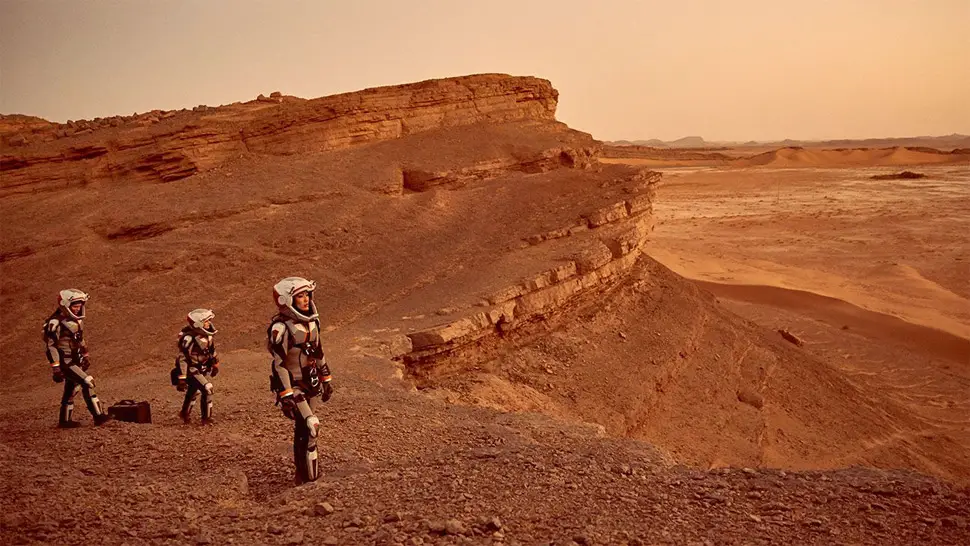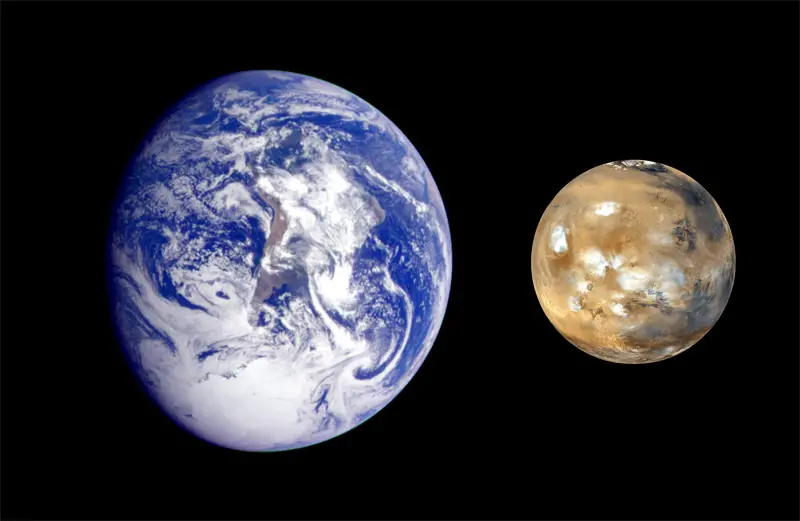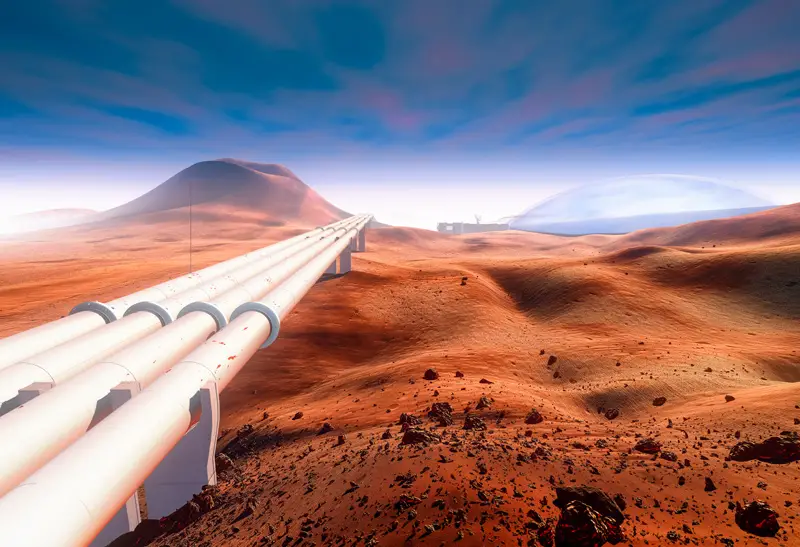
31st July 2016 New TV series will follow Mars mission set in 2033 National Geographic has announced "MARS" – a six-part TV series debuting around the world this November that will follow the first human exploration of the Red Planet.
Of all the planets in our Solar System, none has captured our collective imagination like Mars: a mysterious, indelible part of the zeitgeist. Visible in the night sky for as long as humans have been around, its striking red colour has symbolised blood, passion, anger and love. The existence of Mars as a wandering object was noted by ancient Egyptian astronomers and by 1534 BCE they were familiar with its retrograde motion. In 1610, the Italian astronomer Galileo became the first person to see it via telescope. By the 19th century, the resolution of telescopes had reached a level sufficient for surface features to be identified and the first detailed map was produced in 1877. Seasonal changes, combined with observations of "canals", led to speculation about life on Mars, and it was a long-held belief that vast seas and vegetation were present. When the first spacecraft began visiting the planet during the 1960s and 70s, Mars was revealed to be a dead and barren planet. However, the search for life would continue. Since then, various rovers have explored the surface, with ever larger science payloads and exponentially more detailed imagery. We now know that huge volumes of liquid water existed on Mars in the ancient past and that small amounts are still present under certain conditions. Today, we stand on the cusp of the first human missions to Mars. In the near future, it will be technically and financially viable to send people there, beginning a whole new chapter in the history of our species. The Red Planet would offer a second home for humanity, safeguarding us from the various threats on Earth and greatly boosting our chances of survival into the far future. An independent, self-sustaining Mars could be used as a blank slate to forge a more rational, egalitarian and scientifically-minded world – much like the future depicted in Kim Stanley Robinson's epic trilogy.
As the prospect of exploring and settling this far-away planet moves ever closer to becoming a reality, it has engaged the top minds in science in a modern-day space race, and infiltrated pop culture through blockbusters like Andy Weir's "The Martian" and through out-of-this-world tweets from astronaut Scott Kelly. Now, the National Geographic Channel (NGC), working with a team of award-winning producers, has announced the launch of a global event series later this year. Premiering on the NGC in 171 countries and 45 languages, the TV show – "MARS" – will redefine storytelling by combining feature-film-quality scripted drama and visual effects with best-in-class documentary sequences, to drive forward a cohesive, edge-of-your seat story of mankind's thrilling quest to colonise Mars. This epic, six-part series, debuting in November, is filmed from the vantage point of a fictitious crewed mission in 2033. "Brian [Grazer] and I, along with our friends at Radical, had this ambitious idea, which was to create a documentary about the quest to go to Mars but also bring it to life in a really dramatic and cinematic way," says the Executive Producer, Ron Howard. "The offer to the audience will be information meets vivid and experiential filmmaking. Nat Geo's ambition was high – and we are really honoured and thrilled to try and meet that challenge." The starting point for this unique storytelling method is the year 2033. As dramatic scripted elements and feature film-calibre visual effects bring this future world to life, the modern-day quest to reach the Red Planet is told in a documentary style, and through interviews with present-day scientists and innovators who are researching and developing the space technology to make such a mission possible. Executive producers Howard and Grazer hand-selected visionary Mexican filmmaker Everardo Gout ("Days of Grace") to direct the scripted portions of the series, filmed in Budapest and Morocco.
MARS envisions the future of space travel funded through a corporate-public partnership of two fictional organisations: the Mars Mission Corporation (MMC), a consortium of aerospace corporations formed in 2022 that builds and manages the technological hardware, and the International Mars Science Foundation (IMSF), created by a coalition of space-faring nations. The scripted portion will focus on Earth's first crewed mission to Mars aboard the spacecraft Daedalus. Its maiden voyage is crewed by a carefully selected international crew of six uniquely qualified astronauts, including American mission commander Ben Sawyer (Ben Cotton), Korean American mission pilot Hana Seung (Jihae), Spanish hydrologist and geochemist Javier Delgado (Alberto Ammann), French mission physician and biochemist Amelie Durand (Clementine Poidatz), Nigerian mechanical engineer and roboticist Robert Foucault (Sammi Rotibi) and Russian exobiologist and geologist Marta Kamen (Anamaria Marinca). Back on Earth, the MMC control team, based in London, includes Hana Seung's twin sister, capsule communicator (CAPCOM) Joon Seung (also played by Jihae) and French CEO of the MMC Ed Grann (Olivier Martinez). Once Daedalus successfully lands on Mars and establishes a preliminary base of operations, British nuclear physicist Leslie Richardson (Cosima Shaw) will lead a Phase 2 settlement team along with her husband, world-renowned experimental botanist Dr. Paul Richardson (John Light). The production team took painstaking efforts to base the scripted narrative on real-world science. The writing team worked extensively with experts – both in the public and private sectors – to understand how the science could serve the story. Dr. Robert Braun, an aerospace engineer and professor of space technology at the Georgia Institute of Technology, provided expert consultation on all scientific aspects of the fictional storyline. Dr. Mae Jemison, former NASA astronaut and the first woman of colour in space, acted as a space advisor on the series, working closely with the cast to help them hone their portrayals. In terms of the visual look of the series, production designer Sophie Becher turned to NASA and SpaceX to craft her designs for the Daedalus spaceship and Olympus Town, the first human colony on Mars as portrayed by the series. Costume designer Daniela Ciancio extensively researched the types of fabrics being developed today to make spacesuits lighter, stronger, more flexible and radiation-resistant to protect the astronauts of the future. Framestore, the Academy Award-winning visual effects team behind "Gravity," will layer in the final external visuals to complete the look of the series. MARS also showcases an unprecedented collection of interviews with top scientific minds currently working to overcome the many obstacles that stand in the way of an eventual maiden launch. National Geographic received exclusive access to record Elon Musk (the founder of Tesla and SpaceX) and his team at SpaceX mission control, as they successfully landed their Falcon 9 reusable rocket on a drone ship this past April. "The future of humanity is fundamentally going to bifurcate along one of two directions," says Musk in the series. "Either we're going to become a multi-planet species and a spacefaring civilisation, or we're going to be stuck on one planet, until some eventual extinction event. In order for me to be excited and inspired about the future, it's got to be the first option."
MARS truly brings together all of the world's leading minds in a way never before accomplished – think of the world's largest TED talk with the most fascinating people on Earth. Those interviewed for the series include: • Charles Bolden, NASA administrator; former NASA astronaut The desire not only to reach Mars but also to colonise it has stirred vigorous debate among the space community. The question is not only "could we?" but also "should we?" Neil DeGrasse Tyson is not convinced that we have to send humans to Mars; he bets it would take less effort and less money to figure out how to survive threats to Earth than to colonise another planet in order to maintain the species: "I think we should visit planets, as you'd visit any place you've never been before," he says. "But we evolved on Earth to live on Earth." The consensus seems to be forming that humans will eventually make the trip to Mars, but the timetable for doing so also remains a point of debate. Robert Zubrin, president of The Mars Society and of Pioneer Astronautics, makes a bold assertion: "If the next President were to get up in the spring of 2017 and announce his or her commitment to send humans to Mars, we could be there by the end of that administration's second term." National Geographic will extend the storytelling in an unprecedented, cross-platform effort that includes a six-part companion prequel. Virtual reality experiences will be available at MakeMarsHome.com. There will also be a MARS Experience installation in New York City this October. Further, MARS will be the November cover story of National Geographic magazine and will be featured in a standalone book, "MARS: Our Future on the Red Planet," on sale from 25th October. An NG Kids Book, "MARS: The Red Planet," will go on sale from 27th September and further educational materials will be released. NG Live speakers will also be touring. You can watch the official trailer below. Please subscribe to us at YouTube.com/futuretimelinedotnet.
---
Comments »
|










